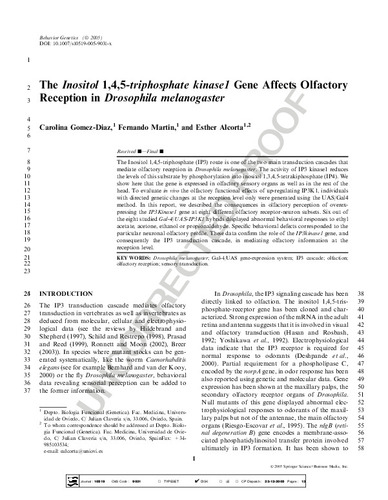The inositol 1,4,5-triphosphate kinase1 gene affects olfactory reception in Drosophila melanogaster
Autor(es) y otros:
Fecha de publicación:
Versión del editor:
Citación:
Descripción física:
Resumen:
The Inositol 1,4,5-triphosphate (IP3) route is one of the two main transduction cascades that mediate olfactory reception in Drosophila melanogaster. The activity of IP3 kinase1 reduces the levels of this substrate by phosphorylation into inositol 1,3,4,5-tetrakiphosphate (IP4). We show here that the gene is expressed in olfactory sensory organs as well as in the rest of the head. To evaluate in vivo the olfactory functional effects of up-regulating IP3K1, individuals with directed genetic changes at the reception level only were generated using the UAS/Gal4 method. In this report, we described the consequences in olfactory perception of overexpressing the IP3Kinase1 gene at eight different olfactory receptor-neuron subsets. Six out of the eight studied Gal-4/UAS-IP3K1 hybrids displayed abnormal behavioral responses to ethyl acetate, acetone, ethanol or propionaldehyde. Specific behavioral defects corresponded to the particular neuronal olfactory profile. These data confirm the role of the IP3kinase1 gene, and consequently the IP3 transduction cascade, in mediating olfactory information at the reception level.
The Inositol 1,4,5-triphosphate (IP3) route is one of the two main transduction cascades that mediate olfactory reception in Drosophila melanogaster. The activity of IP3 kinase1 reduces the levels of this substrate by phosphorylation into inositol 1,3,4,5-tetrakiphosphate (IP4). We show here that the gene is expressed in olfactory sensory organs as well as in the rest of the head. To evaluate in vivo the olfactory functional effects of up-regulating IP3K1, individuals with directed genetic changes at the reception level only were generated using the UAS/Gal4 method. In this report, we described the consequences in olfactory perception of overexpressing the IP3Kinase1 gene at eight different olfactory receptor-neuron subsets. Six out of the eight studied Gal-4/UAS-IP3K1 hybrids displayed abnormal behavioral responses to ethyl acetate, acetone, ethanol or propionaldehyde. Specific behavioral defects corresponded to the particular neuronal olfactory profile. These data confirm the role of the IP3kinase1 gene, and consequently the IP3 transduction cascade, in mediating olfactory information at the reception level.
ISSN:
Patrocinado por:
This study was funded by the Spanish Ministry of Science and Technology (PB97-1269 and BFI2002-00419) and the Spanish Ministry of Health (FISS-03-RED-C03/06). C. Gomez-Diaz was supported by a FICYT fellowship.
Colecciones
- Artículos [37532]
- Biología Funcional [801]
Ficheros en el ítem





